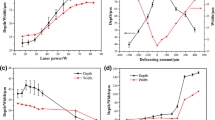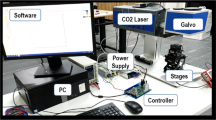Abstract
During the grinding process, K9 optical glass exhibits poor machinability, leading to issues such as crack growth, machining costs, low machining efficiency, and many other problems, seriously restricting its manufacture and application. This paper evaluated the feasibility of picosecond laser-assisted polishing of optical glass workpieces as an economical production method. This study involves a comprehensive exploration of several key aspects, including workpiece dimension control, the surface quality after picosecond laser ablation assessment, the parameters of the picosecond laser equipment optimization, and fine-tuning the parameters of the polishing equipment. The results show that the workpiece surface exhibits a recast layer with an uneven thickness distribution after laser processing, leading to a 38% reduction in luminous flux. Additionally, the roughness of the ablated surface decreases as the pulse repetition rates increase from 40 to 120 kHz. Due to the nonlinear absorption of energy by the amorphous body, the maximum ablation depth occurs around 80 kHz. Furthermore, the unevenly distributed recast layer affects the polishing process. Nevertheless, the efficiency of the picosecond laser-assisted polishing method is greatly improved compared to the conventional method of precision grinding followed by polishing.
























Similar content being viewed by others
References
Zhao P, Zhou M, Huang S (2017) Sub-surface crack formation in ultrasonic vibration-assisted grinding of BK7 optical glass. Int J Adv Manuf Technol 93:1685–1697. https://doi.org/10.1007/s00170-017-0622-5
Perveen A, San WY, Rahman M (2012) Fabrication of different geometry cutting tools and their effect on the vertical micro-grinding of BK7 glass. Int J Adv Manuf Technol 61:101–115. https://doi.org/10.1007/s00170-011-3688-5
Pratap A, Patra K, Dyakonov Aleksandr A (2019) Experimental analysis of ductile-brittle transitions for parallel and intersecting micro-slot grinding in BK-7 glass. Ceram Int 45:11013–11026. https://doi.org/10.1016/j.ceramint.2019.02.185
Alekseeva I, Dymshits O, Tsenter M, Zhilin A, Golubkov V, Denisov I, Skoptsov N, Malyarevich A, Yumashev K (2010) Optical applications of glass-ceramics. J Non Cryst Solids 356:3042–3058. https://doi.org/10.1016/j.jnoncrysol.2010.05.103
Mazo MA, Rubio J (2023) Novel silicon oxycarbide/spodumene glass-ceramic composites with tailored thermal expansion coefficient. J Non Cryst Solids 604:122155. https://doi.org/10.1016/j.jnoncrysol.2023.122155
Xin Z, Wang Y, Fu Q, Cheng H, Cheng X, Zhang J (2021) Effect of glass cover layer on the ballistic performance of transparent ceramic armor. Ceram Int 47:29277–29284. https://doi.org/10.1016/j.ceramint.2021.07.092
Huang C, Zhou M, Zhang H (2022) Investigations on the micro-interactions of grit-workpiece and forces prediction in ultrasonic vibration side grinding of optical glass. J Mater Process Technol 300:117415. https://doi.org/10.1016/j.jmatprotec.2021.117415
Li S, Wang Z, Wu Y (2008) Relationship between subsurface damage and surface roughness of optical materials in grinding and lapping processes. J Mater Process Technol 205:34–41. https://doi.org/10.1016/j.jmatprotec.2007.11.118
Guo Z, Guo B, Wu G, Xiang Y, Meng Q, Jia J, Zhao Q, Li K, Zeng Z (2023) Three-dimensional topography modelling and grinding performance evaluating of micro-structured CVD diamond grinding wheel. Int J Mech Sci 244:108079. https://doi.org/10.1016/j.ijmecsci.2022.108079
Meng Q, Guo B, Li K, Wu G, Zhao H, Jia J, Guo Z, Zhao Q (2024) Stability prediction and optimization of multi-regenerative weak stiffness grinding system based on microstructured tool. Mech Syst Signal Process 208:111010. https://doi.org/10.1016/j.ymssp.2023.111010
Cho BJ, Kim HM, Manivannan R, Moon DJ, Park JG (2013) On the mechanism of material removal by fixed abrasive lapping of various glass substrates. Wear 302:1334–1339. https://doi.org/10.1016/j.wear.2012.11.024
Zhu WL, Beaucamp A (2019) Ultra-precision finishing of low expansion ceramics by compliant abrasive technologies: a comparative study. Ceram Int 45:11527–11538. https://doi.org/10.1016/j.ceramint.2019.03.022
Lin B, Jiang XM, Li S, Cao ZC (2019) Mechanism of material removal by fixed abrasive lapping of fused quartz glass. J Manuf Process 46:279–285. https://doi.org/10.1016/j.jmapro.2019.08.030
Li P, Chen S, Jin T, Yi J, Liu W, Wu Q, Peng W, Dai H (2021) Machining behaviors of glass-ceramics in multi-step high-speed grinding: grinding parameter effects and optimization. Ceram Int 47:4659–4673. https://doi.org/10.1016/j.ceramint.2020.10.033
Dogan Y, Madsen CK (2020) Optimization of ultrafast laser parameters for 3D micromachining of fused silica. Opt Laser Technol 123:105933. https://doi.org/10.1016/j.optlastec.2019.105933
Liao K, Wang W, Mei X, Liu B (2022) High quality full ablation cutting and stealth dicing of silica glass using picosecond laser Bessel beam with burst mode. Ceram Int 48:9805–9816. https://doi.org/10.1016/j.ceramint.2021.12.182
Xiong S, Wang R, Tao H (2021) Ultrafast laser micromachining the ultra-low expansion glass-ceramic: optimization of processing parameters and physical mechanism. J Eur Ceram Soc 41:5990–5999. https://doi.org/10.1016/j.jeurceramsoc.2021.05.018
Skruibis J, Balachninaite O, Butkus S, Vaicaitis V, Sirutkaitis V (2019) Multiple-pulse laser-induced breakdown spectroscopy for monitoring the femtosecond laser micromachining process of glass. Opt Laser Technol 111:295–302. https://doi.org/10.1016/j.optlastec.2018.10.005
Wu J, Rezikyan A, Ross MR, Lezzi PJ, Luo J, Liu A (2022) Temperature and thermal stress analysis of ultrashort laser processed glass. J Non Cryst Solids: X 16:100124. https://doi.org/10.1016/j.nocx.2022.100124
Ryan V, Thomas S, James S, Randolph S, Selim E, Manyalibo M (2013) Thermomechanical modeling of laser-induced structural relaxation and deformation of glass: volume changes in fused silica at high temperatures. J Am Ceram Soc 96:137–145. https://doi.org/10.1111/jace.12110
Stuart BC, Feit MD, Rubenchik AM, Shore BW, Perry MD (1995) Laser-induced damage in dielectrics with nanosecond to subpicosecond pulses. Phys Rev Lett 74:2248–2251. https://doi.org/10.1103/PhysRevLett.74.2248
Tsai CH, Lin BC (2007) Laser cutting with controlled fracture and pre-bending applied to LCD glass separation. Int J Adv Manuf Technol 32:1155–1162. https://doi.org/10.1007/s00170-006-0422-9
Chen J, Zhang F (2019) Research on sub-surface crack depth in surface grinding for optical glass K9 based on grinding speed. Diamond Abras Eng 39:69-74. 10.13394/j.cnki.jgszz.2016.4.0003.
Zhu WL, Beaucamp A (2020) Compliant grinding and polishing: a review. Int J Mach Tools Manuf 158:103634. https://doi.org/10.1016/j.ijmachtools.2020.103634
Toh D, Kayao K, Bui PV, Inagaki K, Morikawa Y, Yamauchi K, Sano Y (2023) Catalyst enhancement approach for improving the removal rate and stability of silica glass polishing via catalyzed chemical etching in pure water. Precis Eng 84:21–27. https://doi.org/10.1016/j.precisioneng.2023.07.003
Uneda M, Kubo N, Hatatani M, Hotta K, Morinaga H (2023) Analysis of the material removal mechanism in chemical mechanical polishing with in-situ macroscale nonwoven pad contact interface observation using an evanescent field. Precis Eng 82:281–289. https://doi.org/10.1016/j.precisioneng.2023.04.002
Chen H, Wei C, Cao Z, Peng X, Jiang Z, Wan S, Shao J (2023) Improving polishing efficiency of RB-SiC through femtosecond laser pretreatment. Appl Surf. Sci 631:157574. https://doi.org/10.1016/j.apsusc.2023.157574
Loiko PA, Dymshits OS, Skoptsov NA, Malyarevich AM, Zhilin AA, Alekseeva IP, Tsenter MY, Bogdanov KV, Mateos X, Yumashev KV (2017) Crystallization and nonlinear optical properties of transparent glass-ceramics with Co:Mg(Al,Ga)2O4 nanocrystals for saturable absorbers of lasers at 1.6-1.7μm. J Phys Chem Solids 103:132–141. https://doi.org/10.1016/j.jpcs.2016.12.017
Miyamoto I, Cvecek K, Schmidt M (2011) Evaluation of nonlinear absorptivity and absorption region in fusion welding of glass using ultrashort laser pulses. Physics Procedia 12:378–386. https://doi.org/10.1016/j.phpro.2011.03.147
Gattass R, Mazur E (2008) Femtosecond laser micromachining in transparent materials. Nat Photonics 2:219–225. https://doi.org/10.1038/nphoton.2008.47
Funding
This project was sponsored by the Natural Science Foundation for Distinguished Young Scholar of Hunan Province (grant no. 2021JJ10031), the National Natural Science Foundation of China (grant no. 52375053), the National Natural Science Foundation of China (grant no. 52227809), the Natural Science Foundation of Hunan Province (grant no. 2023JJ50042), and the Hunan Provincial Innovation Foundation for Postgraduate(grant no. CX20231193).
Author information
Authors and Affiliations
Corresponding author
Ethics declarations
Competing interests
The authors declare no competing interests.
Additional information
Publisher’s Note
Springer Nature remains neutral with regard to jurisdictional claims in published maps and institutional affiliations.
Rights and permissions
Springer Nature or its licensor (e.g. a society or other partner) holds exclusive rights to this article under a publishing agreement with the author(s) or other rightsholder(s); author self-archiving of the accepted manuscript version of this article is solely governed by the terms of such publishing agreement and applicable law.
About this article
Cite this article
Wu, L., Zhang, X., Zhang, Y. et al. Research on picosecond laser-assisted polishing of K9 optical glass: investigation of processing parameters and physical mechanism. Int J Adv Manuf Technol 131, 1897–1917 (2024). https://doi.org/10.1007/s00170-024-13170-1
Received:
Accepted:
Published:
Issue Date:
DOI: https://doi.org/10.1007/s00170-024-13170-1




